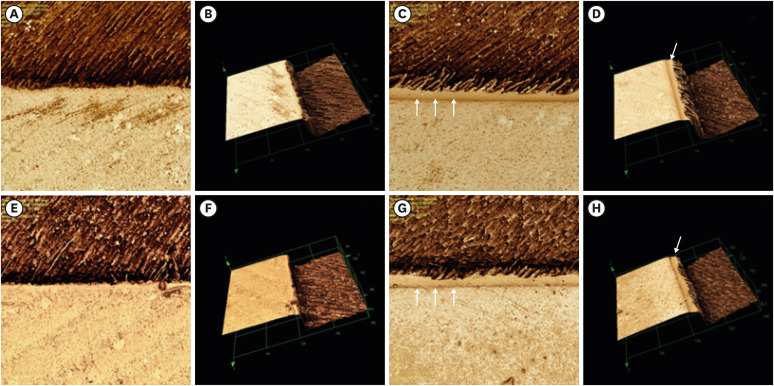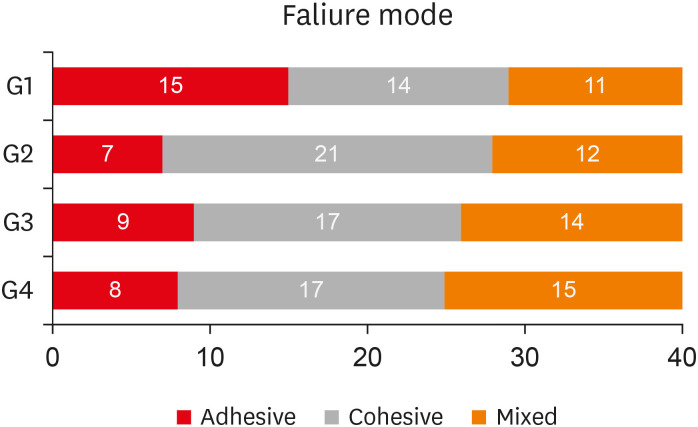1. Roberts S, Kim JR, Gu LS, Kim YK, Mitchell QM, Pashley DH, Tay FR. The efficacy of different sealer removal protocols on bonding of self-etching adhesives to AH plus-contaminated dentin. J Endod. 2009; 35:563–567. PMID:
19345806.

2. Bandeca MC, Kuga MC, Diniz AC, Jordão-Basso KC, Tonetto MR. Effects of the residues from the endodontic sealers on the longevity of esthetic restorations. J Contemp Dent Pract. 2016; 17:615–617. PMID:
27659075.

3. Bakaus TE, Gruber YL, Reis A, Gomes JC, Gomes GM. Bonding properties of universal adhesives to root canals prepared with different rotary instruments. J Prosthet Dent. 2019; 121:298–305. PMID:
30017154.

4. Kuga MC, Faria G, Rossi MA, do Carmo Monteiro JC, Bonetti-Filho I, Berbert FL, Keine KC, Só MV. Persistence of epoxy-based sealer residues in dentin treated with different chemical removal protocols. Scanning. 2013; 35:17–21. PMID:
22700418.

5. Mushtaq M, Masoodi A, Farooq R, Yaqoob Khan F. The dissolving ability of different organic solvents on three different root canal sealers:
in vitro study. Iran Endod J. 2012; 7:198–202. PMID:
23130079.
6. Korasli D, Ziraman F, Ozyurt P, Cehreli SB. Microleakage of self-etch primer/adhesives in endodontically treated teeth. J Am Dent Assoc. 2007; 138:634–640. PMID:
17473042.

7. Demırbuga S, Pala K, Topçuoğlu HS, Çayabatmaz M, Topçuoğlu G, Uçar EN. Effect of different gutta-percha solvents on the microtensile bond strength of various adhesive systems to pulp chamber dentin. Clin Oral Investig. 2017; 21:627–633.

8. Kaczor K, Krasowski M, Lipa S, Sokołowski J, Nowicka A. How do the etching mode and thermomechanical loading influence the marginal integrity of universal adhesives? Oper Dent. 2020; 45:306–317. PMID:
31750802.

9. Leite MLAES, Costa CAS, Duarte RM, Andrade AKM, Soares DG. Bond strength and cytotoxicity of a universal adhesive according to the hybridization strategies to dentin. Braz Dent J. 2018; 29:68–75. PMID:
29267527.

10. Muñoz MA, Luque I, Hass V, Reis A, Loguercio AD, Bombarda NH. Immediate bonding properties of universal adhesives to dentine. J Dent. 2013; 41:404–411. PMID:
23499568.

11. Oliveira SS, Pugach MK, Hilton JF, Watanabe LG, Marshall SJ, Marshall GW Jr. The influence of the dentin smear layer on adhesion: a self-etching primer vs. a total-etch system. Dent Mater. 2003; 19:758–767. PMID:
14511734.

12. Jordão-Basso KC, Kuga MC, Bandéca MC, Duarte MA, Guiotti FA. Effect of the time-point of acid etching on the persistence of sealer residues after using different dental cleaning protocols. Braz Oral Res. 2016; 30:e133. PMID:
28001242.

13. Langer A, Ilie N. Dentin infiltration ability of different classes of adhesive systems. Clin Oral Investig. 2013; 17:205–216.

14. Hass V, Cardenas A, Siqueira F, Pacheco RR, Zago P, Silva DO, Bandeca MC, Loguercio AD. Bonding performance of universal adhesive systems applied in etch-and-rinse and self-etch strategies on natural dentin caries. Oper Dent. 2019; 44:510–520. PMID:
31461392.

15. Wagner A, Wendler M, Petschelt A, Belli R, Lohbauer U. Bonding performance of universal adhesives in different etching modes. J Dent. 2014; 42:800–807. PMID:
24814138.

16. Rosa WL, Piva E, Silva AF. Bond strength of universal adhesives: a systematic review and meta-analysis. J Dent. 2015; 43:765–776. PMID:
25882585.

17. Morais JMP, Victorino KR, Escalante-Otárola WG, Jordão-Basso KCF, Palma-Dibb RG, Kuga MC. Effect of the calcium silicate-based sealer removal protocols and time-point of acid etching on the dentin adhesive interface. Microsc Res Tech. 2018; 81:914–920. PMID:
29904966.

18. Kuga MC, Só MV, De Faria-júnior NB, Keine KC, Faria G, Fabricio S, Matsumoto MA. Persistence of resinous cement residues in dentin treated with different chemical removal protocols. Microsc Res Tech. 2012; 75:982–985. PMID:
22419602.

19. Martos J, Bassotto AP, González-Rodríguez MP, Ferrer-Luque CM. Dissolving efficacy of eucalyptus and orange oil, xylol and chloroform solvents on different root canal sealers. Int Endod J. 2011; 44:1024–1028. PMID:
21658077.

20. Shenoi PR, Badole GP, Khode RT. Evaluation of softening ability of Xylene & Endosolv-R on three different epoxy resin based sealers within 1 to 2 minutes - an
in vitro study. Restor Dent Endod. 2014; 39:17–23. PMID:
24516825.

21. Kuga MC, Só MV, De Campos EA, Faria G, Keine KC, Dantas AA, Faria NB Jr. Persistence of endodontic methacrylate-based cement residues on dentin adhesive surface treated with different chemical removal protocols. Microsc Res Tech. 2012; 75:1432–1436. PMID:
22718396.

22. Guzmán-Armstrong S, Armstrong SR, Qian F. Relationship between nanoleakage and microtensile bond strength at the resin-dentin interface. Oper Dent. 2003; 28:60–66. PMID:
12540120.
23. Cardoso MV, de Almeida Neves A, Mine A, Coutinho E, Van Landuyt K, De Munck J, Van Meerbeek B. Current aspects on bonding effectiveness and stability in adhesive dentistry. Aust Dent J. 2011; 56(Supplement 1):31–44. PMID:
21564114.

24. Pane ES, Palamara JE, Messer HH. Critical evaluation of the push-out test for root canal filling materials. J Endod. 2013; 39:669–673. PMID:
23611388.

25. Yoshiyama M, Urayama A, Kimochi T, Matsuo T, Pashley DH. Comparison of conventional vs self-etching adhesive bonds to caries-affected dentin. Oper Dent. 2000; 25:163–169. PMID:
11203811.
26. Hanabusa M, Mine A, Kuboki T, Momoi Y, Van Ende A, Van Meerbeek B, De Munck J. Bonding effectiveness of a new ‘multi-mode’ adhesive to enamel and dentine. J Dent. 2012; 40:475–484. PMID:
22381614.

27. Perdigão J, Sezinando A, Monteiro PC. Laboratory bonding ability of a multi-purpose dentin adhesive. Am J Dent. 2012; 25:153–158. PMID:
22988685.
28. Perdigão J, Kose C, Mena-Serrano AP, De Paula EA, Tay LY, Reis A, Loguercio AD. A new universal simplified adhesive: 18-month clinical evaluation. Oper Dent. 2014; 39:113–127. PMID:
23802645.

29. Chen C, Niu LN, Xie H, Zhang ZY, Zhou LQ, Jiao K, Chen JH, Pashley DH, Tay FR. Bonding of universal adhesives to dentine--old wine in new bottles? J Dent. 2015; 43:525–536. PMID:
25797702.
30. Heintze SD, Rousson V, Mahn E. Bond strength tests of dental adhesive systems and their correlation with clinical results - a meta-analysis. Dent Mater. 2015; 31:423–434. PMID:
25711699.

31. Hirokane E, Takamizawa T, Kasahara Y, Ishii R, Tsujimoto A, Barkmeier WW, Latta MA, Miyazaki M. Effect of double-layer application on the early enamel bond strength of universal adhesives. Clin Oral Investig. 2021; 25:907–921.
32. Fujiwara S, Takamizawa T, Barkmeier WW, Tsujimoto A, Imai A, Watanabe H, Erickson RL, Latta MA, Nakatsuka T, Miyazaki M. Effect of double-layer application on bond quality of adhesive systems. J Mech Behav Biomed Mater. 2018; 77:501–509. PMID:
29040961.
33. Taschner M, Kümmerling M, Lohbauer U, Breschi L, Petschelt A, Frankenberger R. Effect of double-layer application on dentin bond durability of one-step self-etch adhesives. Oper Dent. 2014; 39:416–426. PMID:
24191868.









 PDF
PDF Citation
Citation Print
Print





 XML Download
XML Download